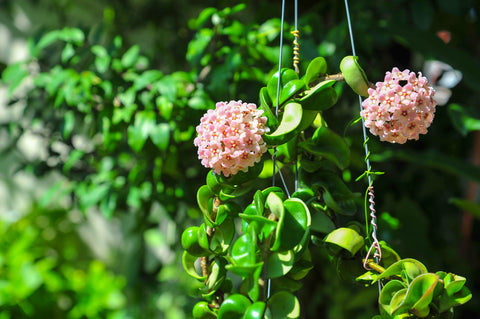Let’s take a look at its care tips and learn how to give your Hoya the kind of love it needs!
• Basic Information

- Common name: Wax Plant, Porcelain flower plant
- Botanical name: Hoya carnosa, hoya kerrii, Hoya australis, etc
- Famous plant members: Eskimo, Retusa, Bella, Fitchii, Shepherdii, etc
- Sunlight: Partial to bright indirect sunlight
- Air: Well ventilated
- Soil: Very well-draining soil with organic matter. A mix of equal parts Ugaoo Pot-o-mix and garden soil, with a part of perlite should work well.
- Water: When the potting is almost dry. Allow the soil to dry out in between waterings.
- Fertilizers: Once every two to three weeks
- Possible Issues: Rot due to overwatering and aphids, mealy bugs, and spider mites
• Sunlight for Hoya

• Placement of Hoya

Hoyas do extremely well indoors in bright indirect light. Place them next to a natural light source like windows facing any direction, with filtered light. In case, you have a south or west-facing room, you can keep the plant almost anywhere in the room till its view of the window is not blocked.
Hoyas look great in hanging baskets too - hang them on your windowsills or north and east-facing balconies to enjoy their stunning foliage swaying gently in the breeze.
Buy the Hanging Twisted Hoya
• Watering the Hoya

Hoyas love their soil to be dried out in between to watering sessions. Keep an eye on the soil color and texture to determine when the soil is almost dry and then water. Don’t let the potting mix remain dry for long.
Hoyas are in a manner of speaking tropical succulents that do better with underwatering than overwatering. However, being tropical they love their occasional misting for humidity.
When watering extremely dried out soil (visible cracks and soil leaving the planter walls), water in batches. Watering all at once allows the water to simply pass through the soil without getting absorbed.
Every time a plant is watered, water it thoroughly till you see some draining out of the drainage hole, and always empty the under-plate.
• Soil for Hoya

Hoyas don’t like wet soil and prefer a growing medium that is almost epiphytic in nature. You can use a mix of succulent potting mix with equal parts regular potting mix or a mix of equal parts of orchid potting mix and regular potting mix.
• Fertilizers for Hoya

Feed your Hoyas with a generic houseplant fertilizer every three weeks, diluted as instructed on the packaging. Fertilizing during the growing period of spring and summer is especially important, as they are slow growers and the growing season must be capitalized upon.
Ensure that the fertilizers have the three major nutrients, nitrogen, phosphorous, and potassium. Ugaoo’s Plant Tonic and NPK are great options for both root and foliar applications.
• Pruning of Hoya

When the Hoya flowers have withered away, don’t cut the flower stalk as it might grow some new flowers on the same stalk. If you want to propagate hoya, take a stem cutting with at least two leaf nodes. Strip away the lower leaves and retain only the top one or two leaves, submerge the exposed leaf node either in soil or water and keep it in an area with partial sunlight and wait for the roots to appear.
• Plant Problems for Hoya

- Yellow and floppy leaves mean that your Hoya could be overwatered. Water only when the soil is dry to touch.
- Brownish and dehydrated leaves indicate excessive heat and lack of humidity.
- A limp Hoya is generally a sign of either overwatering or underwatering. Check the soil and err on the side of underwatering.
- Etiolated or leggy plants with extra-large spaces in between leaves is a sign of lack of light.
- Stalled growth can be either due to lack of light, no nutrients, or hibernation in winters.
- The buds in Hoya plants fall as a response to watering problems. Do not let the soil dry out for too long and mist occasionally.
- Your Hoya plant might not flower if you keep them away from the sun for too long. To make your hoya flower, place them in at least morning or evening sun in the flowering season o spring or summer.
- Hoyas are vulnerable to sap-sucking pests like aphids, mealybugs, and spider mites. Wipe down with soap solution and spray neem oil.
- Shift your Hoya indoors if you experience harsh winters to avoid leaf loss.













